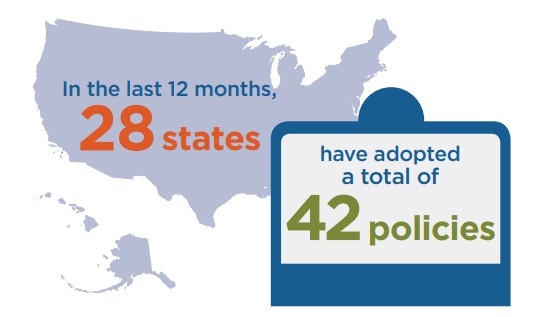| The State of Computer Science Education 2020 |
| Written by Sue Gee | |||
| Wednesday, 18 November 2020 | |||
|
The majority of US schools still do not teach Computer Science, despite the concerted efforts of Code.org Advocacy Coalition. On the other hand, a lot of progress has been made and the number of students taking the AP Computer Science exams has "skyrocketed". When Code.org launched in February 2013, proclaiming the message that "Every student in school should have the opportunity to learn to code", it reported the statistic that in the US 90% of schools didn't offer computer programming classes. Code.org's campaign, which introduced the "Hour of Code" not only in the US but across the globe, certainly had a positive impact. It success stories in the US include Computer Science becoming an official STEM subject in 2015 and President Obama's Computer Science for All initiative to expand access to K-12 computer science education, announced in January 2016. However, there is still a long way to go in the US to achieve universal CS education, as revealed in a new report: 2020 State of Computer Science Education: Illuminating Disparities. Co-authored by Code.org, the Computer Science Teachers Association (CSTA), and the Expanding Computing Education Pathways (ECEP) Alliance, it takes a critical look at K-12 computer science education across the U.S.
Reporting that less than half, 47% of high school in the United States teach foundational computer science, the report sets out to highlight disparaties in access: Computer science is far from immune to the effects of societal inequities and systemic racism: Black/ African American students, Hispanic/Latino/Latina students, and Native American/Alaskan students are less likely to attend a school that teaches a foundational computer science course. Students in rural areas, students with disabilities, English language learners, Native Hawaiian/Pacific Islander students, and economically disadvantaged students are also underrepresented in computer science courses. The report does have news of progress including the fact that since the 2019 State of Computer Science Education report, 28 states have adopted a total of 42 policies to support computer science education.
The policies referred to are nine recommendations proposed by the Code.org Advocacy Coalition to help build and sustain a comprehensive state policy framework to broaden the teaching and learning of computer science. They support a vision built on five principles: Equity and Diversity, Clarity, Capacity, Leadership, and Sustainability. As the map indicates there is wide variation in the adoption of these policies across the United States: The report notes that it is not expected that every state will be able to adopt every policy and comments on achievements: At the time of this report, Arkansas, Idaho, Indiana, Maryland, and Nevada have adopted all nine policies. Many other states have adopted seven or eight policies, including Alabama, Georgia, Iowa, Massachusetts, New Hampshire, Utah, Virginia, Washington, West Virginia, and Wyoming. Several states have made great strides over the past year, not only by adopting more policies, but also ensuring that policies are aligned with one another and implementing actions outlined in previously adopted policies. Maine, Tennessee, and West Virginia each adopted three policies since the last report. Maine adopted a state plan, established a computer science specialist position, and established a policy for students to count a computer science course towards graduation. Tennessee adopted a state plan, a comprehensive set of K–12 standards, and dedicated funding for computer science. West Virginia similarly structured the adoption of policies around the development of the state plan. One important measure of the success of introducing Computer Science into K-12 education in the United States is the number of students taking AP computer science exams. According to the 2020 report this has "skyrocketed": In the 2018–2019 school year, 6,388 schools taught AP computer science, and U.S. students took 158,577 AP computer science exams, up from 5,400 schools and 130,904 students in the 2017–2018 school year. From the outset, Code.org has been concerned to redress the gender disparity in Computer Science and as the graph shows female student participation in AP Computer Science is growing faster than male participation and the overall exam participation is inching closer to parity: However the report states that deeper look at AP computer science exams by gender, race and ethnicity continues to reveal disparities in participation by male and female students from underrepresented groups such that: • Native Hawaiian or Pacific Islander students are 3.5 times less likely to take an AP computer science exam compared to their white and Asian peers who attend a school that teaches it. • Black or African American students are almost 3 times less likely. • Native American or Alaskan students are almost 3 times less likely. • Hispanic, Latino, or Latina students are almost 2 times less likely. So there is still more for the Code.org Advocacy Coalition to do. More Information2020 State of Computer Science Education: Illuminating Disparities Related ArticlesZuckerberg, Gates And More Promoting Computing In Schools Teach Code In School - Before It's Too Late! Hour of Code Aims to Reach 100 Million Worldwide Computer Science Officially US STEM Subject Obama Unveils Computer Science for All To be informed about new articles on I Programmer, sign up for our weekly newsletter, subscribe to the RSS feed and follow us on Twitter, Facebook or Linkedin.
|
|||
| Last Updated ( Wednesday, 18 November 2020 ) |







